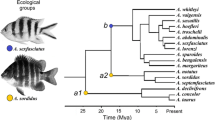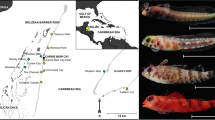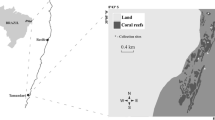Abstract
Species’ niche depends on several ecological and evolutionary factors. Phylogenetically close species may present niche conservatism, retaining their ancestral ecological characteristics. Alternatively, in a situation of limited resources, species can differentiate themselves through changes in their ecological and morphological characteristics to reduce niche overlap, thus facilitating coexistence. In this study, we investigated the ecological niche of two phylogenetically closely related cryptobenthic reef fish species that co-occur in the southern Brazilian coast, Parablennius pilicornis and P. marmoreus. We examined possible overlap in three niche dimensions (thermal, spatial and trophic) to verify if species hold phylogenetic niche conservatism or are partitioning some niche dimension. For this, we studied their densities, microhabitat affinities and diets among four rocky reefs of southern Brazil. The two species presented differences in thermal distribution, and their abundance differed according to depth strata, but no differences were found for microhabitat preferences. They also presented a similar omnivorous diet, with crustaceans and algae as main prey types. The Pianka’s niche overlap values did not differ from the values expected in the null model for thermal and depth, and it was higher than expected by chance for microhabitat and diet. Considering all the niche dimensions analysed together, the total niche overlap was greater than expected at random. These results suggest that the two species are successfully coexisting despite considerable niche overlap. Thus, their coexistence may not depend on the evolution of divergent patterns of resource use, but on the evolutionary history of the species.

Photos: João Paulo Krajewski




Similar content being viewed by others
References
Abrams P (1980) Some comments on measuring niche overlap. Ecology 61:44–49. https://doi.org/10.2307/1937153
Abrams P (1983) The theory of limiting similarity. Annu Rev Ecol Syst 14:359–376. https://doi.org/10.1146/annurev.es.14.110183.002043
Ahmadia G, Tornabene L, Smith D, Pezold F (2018) The relative importance of regional, local, and evolutionary factors structuring cryptobenthic coral-reef assemblages. Coral Reefs 37:279–293. https://doi.org/10.1007/s00338-018-1657-2
Albrecht M, Gotelli NJ (2001) Spatial and temporal niche partitioning in grassland ants. Oecologia 126:134–141. https://doi.org/10.1007/s004420000494
Anderson AB, Silva JP, Sorvilo R, Francini CLB, Floeter SR, Barreiros JP (2020) Population expansion of the invasive Pomacentridae Chromis limbata (Valenciennes, 1833) in southern Brazilian coast: long-term monitoring, fundamental niche availability and new records. J Fish Biol 97:362–373. https://doi.org/10.1111/jfb.14365
Andrades R, Joyeux JC, Macieira RM, Godoy BS, Reis-Filho JA, Jackson AL, Giarrizzo T (2021) Niche-relationships within and among intertidal reef fish species. Front Mar Sci 8:574. https://doi.org/10.3389/fmars.2021.659579
Araújo GS, Vilasboa A, Britto MR, Bernardi G, Von der Heyden S, Levy A, Floeter SR (2020) Phylogeny of the comb-tooth blenny genus Scartella (Blenniiformes: Blenniidae) reveals several cryptic lineages and a trans-Atlantic relationship. Zool J Linnean Soc 190:54–64. https://doi.org/10.1093/zoolinnean/zlz142
Barneche DR, Kulbicki M, Floeter SR, Friedlander AM, Maina J, Allen AP (2014) Scaling metabolism from individuals to reef-fish communities at broad spatial 494 scales. Ecol Lett 17:1067–1076. https://doi.org/10.1111/ele.12309
Bax NJ (1998) The significance and prediction of predation in marine fisheries. ICES J Mar Sci 55:997–1030. https://doi.org/10.1006/jmsc.1998.0350
Begon M, Townsend CR, Harper JL (2006) Ecology: from individuals to ecosystems. Blackwell Publishing, Oxford
Bowen W, Bass AL, Rocha LA, Grant WS, Robertson DR (2001) Phylogeography of the trumpetfishes (Aulostomus): ring species complex on a global scale. Evolution 55:1029–1039. https://doi.org/10.1554/0014-3820(2001)055[1029:pottar]2.0.co;2
Brandl SJ, Goatley C, Bellwood D, Tornabene L (2018) The hidden half: ecology and evolution of cryptobenthic fishes on coral reefs: cryptobenthic reef fishes. Biol Rev 93:1846–1873. https://doi.org/10.1111/brv.12423
Brandl SJ, Tornabene LM, Goatley CHR, Casey JM, Morais RA, Baldwin CC, Côté IM, Parravicini V, Schiettekatte NMD, Bellwood DR (2019) Demographic dynamics of the smallest marine vertebrates fuel coral reef ecosystem functioning. Science 364:1189–1192. https://doi.org/10.1126/science.aav3384
Brandl SJ, Casey JM, Meyer CP (2020) Dietary and habitat niche partitioning in congeneric cryptobenthic reef fish species. Coral Reefs 39:305–317. https://doi.org/10.1007/s00338-020-01892-z
Brown WL, Wilson EO (1956) Character displacement. Syst Zool 5:49–64. https://doi.org/10.2307/2411924
Brown JH, Gillooly JF, Allen AP, Savage VM, West GB (2004) Toward a metabolic theory of ecology. Ecology 85:1771–1789. https://doi.org/10.1890/03-9000
Colwell RK, Futuyma DJ (1971) On the measurement of niche breadth and overlap. Ecology 52:567–576. https://doi.org/10.2307/1934144
Cornell HV (2011) Niche overlap. In: Hastings A, Gross LJ (eds) Encyclopedia of theoretical ecology. University of California Press, Berkeley, pp 489–497
Craiu RV, Duchesne T, Fortin D (2008) Inference methods for the conditional logistic regression model with longitudinal data. Biom J 50:97–109
Dalben A, Floeter SR (2012) Cryptobenthic reef fishes: depth distribution and correlations with habitat complexity and sea urchins. J Fish Biol 80:852–865. https://doi.org/10.1111/j.1095-8649.2012.03231.x
Darwin C (1859) On the origin of species. John Murray, London
Depczynski M, Bellwood D (2003) The role of cryptobenthic reef fishes in coral reef trophodynamics. Mar Ecol Prog Ser 256:183–191. https://doi.org/10.3354/meps256183
Dias RM (2019) Evolução e biodiversidade de peixes recifais criptobentônicos do Oceano Atlântico. PhD thesis, Universidade Federal do Rio de Janeiro, Brazil
Diez JM, Sullivan JJ, Hulme PE, Edwards G, Duncan RP (2008) Darwin’s naturalization conundrum: dissecting taxonomic patterns of species invasions. Ecol Lett 11:674–681. https://doi.org/10.1111/j.1461-0248.2008.01178.x
Dinno A (2017) dunn.test: Dunn's test of multiple comparisons using rank sums. R package version 1.3.5. https://CRAN.R-project.org/package=dunn.test
Ebbert D (2019) chisq.posthoc.test: a post hoc analysis for pearson's chi-squared test for count data. R package version 0.1.2. https://CRAN.R-project.org/package=chisq.posthoc.test
Faria-Junior E, Lindner A (2019) An underwater temperature dataset from coastal islands in Santa Catarina, southern Brazil: high accuracy data from different depths. SEANOE. https://doi.org/10.17882/62120
Fox J, Weisberg S (2019) An r companion to applied regression. Sage, Thousand Oaks
Froese R, Pauly D (2021) FishBase. World Wide Web electronic publication. www.fishbase.org, version (08/2021).
Garvey JE, Whiles MR (2016) Trophic Ecology. Taylor and Francis, Boca Raton. https://doi.org/10.1201/9781315367804
Gause GF (1934) The struggle for existence. Williams and Wilkins, Baltimore
Gotelli NJ, Hart EM, Ellison AM (2015) EcoSimR: null model analysis for ecological data. https://doi.org/10.5281/zenodo.16522
Hardin G (1960) The competitive exclusion principle. Science 131:1292–1297. https://doi.org/10.1126/science.131.3409.1292
Hector A, Hooper R (2002) Darwin and the first ecological experiment. Science 295:639–640. https://doi.org/10.1126/science.1064815
Hixon M, Jones G (2005) Competition, predation, and density-dependent mortality in demersal marine fishes. Ecology 86:2847–2859. https://doi.org/10.1890/04-1455
Hutchinson GE (1957) Concluding Remarks. Cold Spring Harb Symp Quant Biol 22:415–427. https://doi.org/10.1101/SQB.1957.022.01.039
Kawakami E, Vazzoler G (1980) Método gráfico e estimativa de índice alimentar aplicado no estudo de alimentação de peixes. Braz J Oceanogr 29:205–207. https://doi.org/10.1590/S0373-55241980000200043
Knight NS, Guichard F, Altieri AH (2021) A global meta-analysis of temperature effects on marine fishes’ digestion across trophic groups. Glob Ecol Biogeogr 00:1–16. https://doi.org/10.1111/geb.13262
Kraft NJ, Cornwell WK, Webb CO, Ackerly DD (2007) Trait evolution, community assembly, and the phylogenetic structure of ecological communities. Am Nat 170:271–283. https://doi.org/10.1086/519400
Lehner PN (1996) Handbook of ethological methods. Cambridge University Press, Cambridge
Lemon J (2006) Plotrix: a package in the red-light district of R. R-News 6(4):8–12
Levy A, von der Heyden S, Floeter SR, Bernardi G, Almada VC (2013) Phylogeny of Parablennius Miranda Ribeiro, 1915 reveals aparaphyletic genus and recent Indo-Pacific diversification from an Atlantic ancestor. Mol Phylogenet Evol 67:1–8. https://doi.org/10.1016/j.ympev.2012.12.010
Liedke AMR, Barneche DR, Ferreira CEL, Segal B, Nunes LT, Burigo APC, Carvalho JA, Buck S, Bonaldo R, Floeter SR (2016) Abundance, diet, foraging and nutritional condition of the banded butterflyfish (Chaetodon striatus) along the western Atlantic. Mar Biol 163:6. https://doi.org/10.1007/s00227-015-2788-4
Liedke AMR, Bonaldo RM, Segal B, Ferreira CEL, Nunes LT, Burigo AP, Buck S, Oliveira-Santos LGR, Floeter SR (2018) Resource partitioning by two syntopic sister-species of butterflyfish (Chaetodontidae). J Mar Biolog Assoc UK 98:1767–1773. https://doi.org/10.1017/S0025315417001321
Lindquist DG, Dillaman RM (1986) Trophic morphology of four Western Atlantic Blennies (Pisces: Blenniidae). Copeia 1:207–2013. https://doi.org/10.2307/1444909
Luiz OJ, Floeter SR, Gasparini JL, Ferreira CEL, Wirtz P (2004) The occurrence of the African surgeonfish Acanthurus monroviae (Perciformes: Acanthuridae) in the southwestern Atlantic, with comments on other eastern Atlantic reef fishes occurring in Brazil. J Fish Biol 65:1173–1179. https://doi.org/10.1111/j.0022-1112.2004.00519.x
MacArthur RH (1958) Population ecology of some warblers of Northeastern coniferous forests. Ecology 39:599–619. https://doi.org/10.2307/1931600
Magnuson JJ, Crowder LB, Medvick PA (1979) Temperature as an ecological resource. Am Zool 19:331–343. https://doi.org/10.1093/icb/19.1.331
Manly BFJ (1993) A review of computer intensive multivariate methods in ecology. In: Patil GP, Rao CR (eds) Multivariate environmental statistics. Elsevier, Amsterdam, pp 307–346
Manly BFJ (1997) Randomization, bootstrap and Monte Carlo methods in biology. Chapman and Hall, London
Manly BFJ, McDonald LL, Thomas DL (1993) Resource selection by animals: statistical design and analysis for field studies. Chapman and Hall, London
McPeek M, Gomulkiewicz R (2005) Assembling and depleting species richness in metacommunities: insights from ecology, population genetics, and macroevolution. In: Holyoak M, Leibold MA, Holt RD (eds) Metacommunities: spatial dynamics and ecological communities. University of Chicago Press, Chicago, pp 355–373
Morais RA, Ferreira CEL, Floeter SR (2017) Spatial patterns of fish standing biomass across Brazilian reefs, Southwestern Atlantic. J Fish Biol 91:1642–1667. https://doi.org/10.1111/jfb.13482
Munday PL (2004) Competitive coexistence of coral-dwelling fishes: the lottery hypothesis revisited. Ecology 85:623–628. https://doi.org/10.1890/03-3100
Munkemuller T, Boucher FC, Thuiller W, Lavergne S (2015) Phylogenetic niche conservatism, common pitfall, and ways forward. Funct Ecol 29:627–639. https://doi.org/10.1111/1365-2435.12388
Nieder J (1997) Seasonal variation in feeding patterns and food niche overlap in the mediterranean blennies Scartella cristata, Parablennius pilicornis and Lipophrys trigloides (Pisces: Blenniidae). Mar Ecol 18:227–237. https://doi.org/10.1111/j.1439-0485.1997.tb00439.x
Nielsen JM, Clare EL, Hayden B, Brett MT, Kratina P (2018) Diet tracing in ecology: methods comparison and selection. Methods Ecol Evol 9:278–291. https://doi.org/10.1111/2041-210X.12869
Nunes L, Siqueira AC, Cord I, Ford BM, Liedke AMR, Ferreira CEL, Floeter SR (2020) The influence of species abundance, diet and phylogenetic affinity on the co-occurrence of butterflyfishes. Mar Biol 167:107. https://doi.org/10.1007/s00227-020-03725-7
Oksanen J, Blanchet FG, Friendly M, Kindt R, Legendre P, McGlinn D, Minchin PR, O'Hara RB, Simpson GL, Solymos P, Stevens MHH, Szoecs E, Wagner H (2019) vegan: community ecology package. R package version 2.5-5. https://CRAN.R-project.org/package=vegan
Patzner RA, Hastings PA, Springer VG, Wirtz P, Gonçalves EJ (2009) List of valid species of Blennies. In: Patzner RA, Gonçalves EJ, Kapoor BG (eds) The biology of Blennies. Science Publishers, New Hampshire, pp 443–473
Peterson AT (2011) Ecological niche conservatism: a time-structured review of evidence. J Biogeogr 38:817–827. https://doi.org/10.1111/j.1365-2699.2010.02456.x
Peterson AT, Soberón J, Sánchez-Cordero V (1999) Conservatism of ecological niches in evolutionary time. Science 285:1265–1267. https://doi.org/10.1126/science.285.5431.1265
Pianka ER (1973) The structure of lizard communities. Annu Rev Ecol Syst 4:53–74. https://doi.org/10.1146/annurev.es.04.110173.000413
Pianka ER, Vitt LJ, Pelegrin N, Fitzgerald DB, Winemiller KO (2017) Toward a periodic table of niches, or exploring the lizard niche hypervolume. Am Nat 190:601–616. https://doi.org/10.1086/693781
Pinheiro HT, Rocha LA, Macieira RM, Carvalho-Filho A, Anderson AB, Bender MG, Di Dario F, Ferreira CEL, Figueiredo-Filho J, Francini-Filho R, Gasparini JL, Joyeux JC, Luiz OJ, Mincarone MM, Moura RL, Nunes JACC, Quimbayo JP, Rosa RS, Sampaio CLS, Sazima I, Simon T, Vila-Nova DA, Floeter SR (2018) Southwestern Atlantic reef fishes: zoogeographic patterns and ecological drivers reveal a secondary biodiversity center in the Atlantic Ocean. Divers Distrib 24:951–965. https://doi.org/10.1111/ddi.12729
Pinksy ML, Selden RL, Kitchel ZJ (2020) Climate-driven shifts in marine species ranges: scaling from organisms to communities. Ann Rev Mar Sci 12:153–179. https://doi.org/10.1146/annurev-marine-010419-010916
Quimbayo JP, Giglio VJ, Ferreira CEL, Fraga A, Nunes JACC, Mendes TC (2020) Contrasting feeding and agonistic behaviour of two blenny species on a small and remote island in the equatorial Atlantic Ocean. J Fish Biol 96:74–82. https://doi.org/10.1111/jfb.14180
R Core Team (2018) R: a language and environment for statistical computingR Foundation for Statistical Computing, Vienna. https://www.R-project.org/
Rangel CA (2007) Peixes recifais criptobênticos de Arraial do Cabo, RJ: Composição, estrutura da comunidade e comparações biogeográficas. PhD thesis, Universidade Federal Fluminense, Brazil
Rangel CA, Guimarães RZP (2010) Taxonomia e distribuição da família Blenniidae (Teleostei: Blennioidei) na costa leste do Brasil. Revista Brasileira De Zoociências 12:17–41
Ricklefs RE, Relyea R (2018) Ecology: the economy of nature. W. H. Freeman and Company, New York
Sale PF (1978) Coexistence of coral reef fishes—a lottery for living space. Environ Biol Fish 3:85–102. https://doi.org/10.1007/BF00006310
Sale PF (2006) Coral reef fishes—dynamics and diversity in a complex ecosystem. Academic Press, San Diego
Santos S, Hrbek T, Farias IP, Schneider H, Sampaio I (2006) Population genetic structuring of the king weakfish, Macrodon ancylodon (Sciaenidae), in Atlantic coastal waters of South America: deep genetic divergence without morphological change. Mol Ecol 15:4361–4373. https://doi.org/10.1111/j.1365-294X.2006.03108.x
Schoener TW (1971) Theory of feeding strategies. Ann Rev Ecolog Sys 2:369–404
Segal B, Freire AS, Lindner A, Krajewski JP, Soldateli M (2017) MAArE - Monitoramento Ambiental da Reserva Biológica Marinha do Arvoredo e Entorno. Universidade Federal de Santa Catarina, Florianópolis
Shpigel M (1982) Niche overlap among two species of coral dwelling fishes of the genus Dascyllus (Pomacentridae). Environ Biol Fishes 7:65–68
Slatkin M (1980) Ecological character displacement. Ecology 61:163–177. https://doi.org/10.2307/1937166
Therneau T (2015) A package for survival analysis in R. https://CRAN.R-project.org/package=survival
Thuiller W, Gallien L, Boulangeat I, Bello FD, Münkemüller T, Roquet C, Lavergne S (2010) Resolving Darwin’s naturalization conundrum: a quest for evidence. Divers Distrib 16:461–475. https://doi.org/10.1111/j.1472-4642.2010.00645.x
Tracy R, Christian K (1986) Ecological relations among space, time, and thermal niche axes. Ecology 67:609–615. https://doi.org/10.2307/1937684
Venables WN, Ripley BD (2002) Modern applied statistics with S, 4th edn. Springer, New York
Wellborn GA, Langerhans RB (2015) Ecological opportunity and the adaptive diversification of lineages. Ecol Evol 5:176–195. https://doi.org/10.1002/ece3.1347
Wickham H (2016) ggplot2: elegant graphics for data analysis. Springer, New York
Wiens JJ, Donoghue MJ (2004) Historical biogeography, ecology and species richness. Trends Ecol Evol 19:639–644. https://doi.org/10.1016/j.tree.2004.09.011
Wiens JA, Stralberg D, Jongsomjit D, Howell CA, Snyder MA (2009) Niches, models, and climate change: assessing the assumptions and uncertainties. Proc Natl Acad Sci USA 106:19729–19736. https://doi.org/10.1073/pnas.0901639106
Wilson SK, Bellwood DR, Choat JH, Furnas MJ (2003) Detritus in the epilithic algal matrix and its use by coral reef fishes. Oceanogr Mar Biol 41:279–309
Winemiller KO, Fitzgerald DB, Bower LM, Pianka ER (2015) Functional traits, convergent evolution, and periodic tables of niches. Ecol Lett 18:737–751. https://doi.org/10.1111/ele.12462
Wong MYL, Buston PM (2013) Social systems in habitat-specialist reef fishes: key concepts in evolutionary ecology. Bioscience 63:453–463
Acknowledgements
We thank Gabriel S. Araújo, Thiago M. J. Fiuza, Gabriel B. Victorino, and Caroline Leão for sampling and field support. We thank the logistical support for fieldwork provided by ICMBio—REBIO Arvoredo. The sampling on the Arvoredo Island was authorized by ICMBio [#12543-1 and #72574-1 to SRF]. We thank Alberto Lindner, Bárbara Segal, Mariana Mazza and Thiago Mendes for laboratorial equipment and support. AMC and LTN received a scholarship from the Coordenação de Aperfeiçoamento de Pessoal de Nível Superior—Brazil (CAPES) [Financial code 001]. SRF is grateful to his research productivity grant provided by the Brazilian National Council for Scientific and Technological Development (CNPq 307340/2019-8).
Funding
AMC and LTN received a scholarship from the Coordenação de Aperfeiçoamento de Pessoal de Nível Superior—Brazil (CAPES) (financial code 001).
Author information
Authors and Affiliations
Contributions
AMC, LTN and SRF conceived the ideas and designed the study; AMC, LTN and SRF contributed to sampling effort; AMC and LTN performed the gut content analyses; AMC, LTN, and LGROS performed statistical analyses; AMC led the writing; all the authors contributed to the writing and discussions. All authors gave final approval for publication.
Corresponding author
Ethics declarations
Conflict of interest
The authors declare no conflicts of interest.
Ethics approval
We declare that all fishes were sampled according to the international and national guidelines for sampling. Permission for sampling in Brazil was given by the ICMBio Institute (SISBio #12543-1 and #72574-1 to SRF).
Data/code availability
Data is available at the Zenodo platform (https://zenodo.org/record/5813667#.YdHhcGjMLIU).
Additional information
Responsible Editor: K.D. Clements.
Publisher's Note
Springer Nature remains neutral with regard to jurisdictional claims in published maps and institutional affiliations.
Supplementary Information
Below is the link to the electronic supplementary material.
Rights and permissions
About this article
Cite this article
Canterle, A.M., Nunes, L.T., Oliveira-Santos, L.G.R. et al. Syntopic cryptobenthic fishes can coexist with overlapping niches. Mar Biol 169, 26 (2022). https://doi.org/10.1007/s00227-021-04009-4
Received:
Accepted:
Published:
DOI: https://doi.org/10.1007/s00227-021-04009-4




